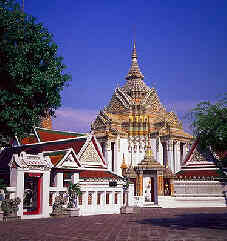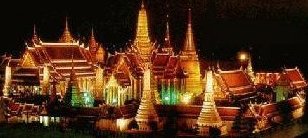|
Dvaravati was a flourishing kingdom of Mon
people in the 7th century. The political influence of the
Dvaravati kingdom extended as far as Northern Thailand. The Haripunjaya
kingdom of the upper Menam valley was an important kingdom in northern
Thailand. Towards the second half of the 7th century AD
Theravada Buddhism was introduced into Haripunjaya.
About the 8th or 9th century
AD, both Thailand and Laos formed part of Kambuja (Cambodia). Both the
Brahmanical religion and Buddhism can be found flourishing side by side
in all these regions.
Theravada Buddhism flourished in the lower Menam
valley under the patronage of the rulers of the Dvaravati kingdom. Both
Mahayanism and Brahmanism existed at the lower Menam valley under the
patronage of the Khmer rulers. Towards the beginning of the 13th
century AD, the Haripunjaya kingdom had become a center of Theravada
Buddhism. Thus, before the Thais established their contact with Sri
Lanka.
About the middle of the 13th century AD,
the Thais made themselves masters of Siam and Laos and put an end to the
political supremacy of the Cambodian over them. Sukhodaya
was established in central Thailand as the capital of Thai kingdom in
the second half of the 13th century. A king named Rocaraja of
Sukhodaya sent an embassy to the king of Sri Lanka requesting him to
send the miraculous Sihala Buddha image to Sukhodaya. The king's request
was granted and Sukhodaya received its first Buddha image from Sri
Lanka.
Around 1317-1347 AD Burma acted as an intermediary
between Sri Lanka and Thailand in the religious intercourse. At the
request of Lothai, the king of Sukhodaya, Udumbara Mahasami sent the
Elder Sumana to establish the Sinhalese form of the monastic discipline
and in order to reorganize and model the Buddhist Sangha of Thailand on
that of Sri Lanka. In his reign a Thai prince assumed the yellow robe
and made a journey to India and Sri Lanka, from which countries he
claims to have brought back miraculous relics. A few years later, Kilana,
the king of Nabbisipura requested Udumbara Mahasami to send a monk
capable of performing all religious acts. As a consequence Ananda thera
was sent to Nabbisipura. At the advice of Ananda thera, the king of
Nabbisipura then requested the king of Sukhodaya and invited Elder
Sumana to his kingdom. In this way, king Kilana and Sumana contributed
to the establishment of the Sihala Sangha in northern Thailand.
King Luthai /Lo Thai (1347 AD, son of king Lothai)
was not only a great patron of Buddhism, but himself adopted the life of
a buddhist monk, preaching the doctrines of the Buddha all over his
kingdom. About 1361 AD he sent some learned monks and scholars to
Sri Lanka and induced the great monk called Mahasami Samgharaja to come
to Thailand. Under his inspiration and the active efforts of the king,
Buddhism and Pali literature spread to a number of small Hinduized
states in the territories now called Laos. One of his inscriptions,
which gives him the tittle of Sri Suryavamsa Rama Mahadharma Rajadhiraja
furnishes a long account of the reception accorded to a hierarchy from
Sri Lanka invited to Thailand to reorganize the religious institutions
there. As a result, Sukhodaya became a great center of Buddhist studies
in the middle of the 14th century AD. From the second half of
the 14th century onwards Buddhism flourished in Thailand and
the neighboring regions, and Brahmanism declined until it almost
disappeared. A sacred and authentic relic of the Buddha was brought to
Thailand from Sri Lanka and it was installed with great solemnity by the
king at Nagara Jum. A branch of the sacred Bo-tree was brought to
Thailand from Sri Lanka and was planted near this sacred relic at Nagara
Jum.
The establishment of the new kingdom of Ayuthia in
the middle of the 14th century and the change of the
political center of Thai power from Sukhodaya to Ayuthia
marked the beginning of a new era of great cultural prosperity. Under
royal patronage Buddhism flourished and Ayuthia became an important
Buddhist center. Strong religious ties existed between Sri Lanka and
Thailand.
 During the reign of Tissaraja (1401-1442 AD) 25 monks went from
Nabbisipura together with 8 monks from Cambodia went to Sri Lanka to
receive the upasampada ordination and over there they were joined by six
monks from the Ramanna country. These 39 monks studied the sacred texts
thoroughly and also learned the correct manner of recital of the sacred
texts from the Buddhist monks in Sri Lanka. They also took with them the
sacred relic of the Buddha. After their arrival at Ayuthia in southern
Thailand, the king received them, and they ordained the local monks and
established the Sihala Sangha in Thailand. The Sihala fraternity of the
monks also introduced to Thailand a higher standard of Pali scholarship.
During the reign of Tissaraja (1401-1442 AD) 25 monks went from
Nabbisipura together with 8 monks from Cambodia went to Sri Lanka to
receive the upasampada ordination and over there they were joined by six
monks from the Ramanna country. These 39 monks studied the sacred texts
thoroughly and also learned the correct manner of recital of the sacred
texts from the Buddhist monks in Sri Lanka. They also took with them the
sacred relic of the Buddha. After their arrival at Ayuthia in southern
Thailand, the king received them, and they ordained the local monks and
established the Sihala Sangha in Thailand. The Sihala fraternity of the
monks also introduced to Thailand a higher standard of Pali scholarship.
Tissaraja's son, Tilokaraja / Tilakaraja (1442-1487
AD) himself entered the Sangha in 1447 AD for sometime and with the
permission of his teacher he assumed office again as king. In 1455 AD a
seedling grown from the southern branch of the Mahabodhi at Anuradhapura
was planted by King Tilakaraja at Nabbisipura (Chieng Mai). It is said
that Tilakaraja convoked a great council in the Mahabodhi Arama at
Nabbisipura in 1475 AD to revise the Pali scriptures. This council is
known as the Eighth Buddhist Council in the history of
Buddhism in Thailand.
Emperor Tilakapanattu (1495-1525 AD) is regarded as
one of the greatest kings of Thailand. He also installed a great Buddha
statue in the uposatha hall at the Pubbarama. At the time of the
installation important ceremonies were held and he gave dana to several
thousand monks who belonged to the Sihala sect, the Nagaravasigana,
and the Puppharamavasigana. Among the three fraternities,
the Sihala sect became very prominent in Thailand and it
took the leading part in all the ecclesiastical acts and performed the
acts before as well as after the other fraternities participated in
them. In 1515 AD the king conferred the title of Rajaguru (Royal
Teacher) on the Mahasami of the Rattavanamahavihara, which is another
indication of the importance of the Sihala sect in Thailand. The
patronage extended to many scholars and scholarly institutions resulted
in the existence of several well-organized educational and religious
institutions in the country.
King Maha Dhammaraja II (Boromokot) ascended the
throne of Ayuthia in 1733 AD. During his rule Ayuthia became a great
center of Buddhism and religious mission from Sri Lanka came there to
get help and assistance from the Thai monks. About 1750 AD, the king of
Sri Lanka sent messenger to the king of Thailand and the latter sent
golden and silver images of the Buddha, copies of sacred texts and about
10 monks under the leadership of Upali Mahathera. It is clear that at
that time Sri Lanka recognized Thailand to be a country where Buddhism
prevailed in a much purer form.
The Burmese invaders destroyed most of Ayuthia in
1767. As a result of the repeated attacks of the Burmese, the rulers of
Thailand shifted their capital to Banckok. General Chakri, who was known
as Ramal (1782-1809 AD), was the founder of the present reigning dynasty
at Bangkok. Buddhism continued to flourish under the patronage of the
rulers of this dynasty.
In 1828, Thailand's Prince Mongkut (later King Rama
IV) founds the Dhammayut movement, which later became the Dhammayut
Sect.
In 1900, Ven. Ajaan Mun and Ven. Ajaan Sao
revive the forest meditation tradition in Thailand.
In the early 19th century, to prevent the
encroachment of Christian missionaries, Rama V (1868-1910) worked with
his brothers (one of whom was Prince Mongkut) to move the country from a
loose feudal system to a centralized nation-state. By doing that, they
enacted religious reforms to present a united front in the face of
imperialist threats from Britain and France. This Sangha Act formally
marked the beginnings of the Mahanikaya and Dhammayut sects. Sangha
government, which up to that time had been in the hands of a lay
official appointed by the king, is handed over to the bhikkhus. It
wasn't until the 1950's that the movement he founded gained acceptance
in Bangkok, and only in the 1970's did it come into prominence on a
nationwide level.
|
 From the 6th century onwards Theravada Buddhism flourished in
the lower Menam valley and it continued to be the dominant religion
there. But when the lower Menam valley came under the control of the
Khmer rulers who were ardent patrons of Brahmanism and Mahayana
Buddhism, but Theravada still continued to flourish there.
From the 6th century onwards Theravada Buddhism flourished in
the lower Menam valley and it continued to be the dominant religion
there. But when the lower Menam valley came under the control of the
Khmer rulers who were ardent patrons of Brahmanism and Mahayana
Buddhism, but Theravada still continued to flourish there. During the reign of Tissaraja (1401-1442 AD) 25 monks went from
Nabbisipura together with 8 monks from Cambodia went to Sri Lanka to
receive the upasampada ordination and over there they were joined by six
monks from the Ramanna country. These 39 monks studied the sacred texts
thoroughly and also learned the correct manner of recital of the sacred
texts from the Buddhist monks in Sri Lanka. They also took with them the
sacred relic of the Buddha. After their arrival at Ayuthia in southern
Thailand, the king received them, and they ordained the local monks and
established the Sihala Sangha in Thailand. The Sihala fraternity of the
monks also introduced to Thailand a higher standard of Pali scholarship.
During the reign of Tissaraja (1401-1442 AD) 25 monks went from
Nabbisipura together with 8 monks from Cambodia went to Sri Lanka to
receive the upasampada ordination and over there they were joined by six
monks from the Ramanna country. These 39 monks studied the sacred texts
thoroughly and also learned the correct manner of recital of the sacred
texts from the Buddhist monks in Sri Lanka. They also took with them the
sacred relic of the Buddha. After their arrival at Ayuthia in southern
Thailand, the king received them, and they ordained the local monks and
established the Sihala Sangha in Thailand. The Sihala fraternity of the
monks also introduced to Thailand a higher standard of Pali scholarship.